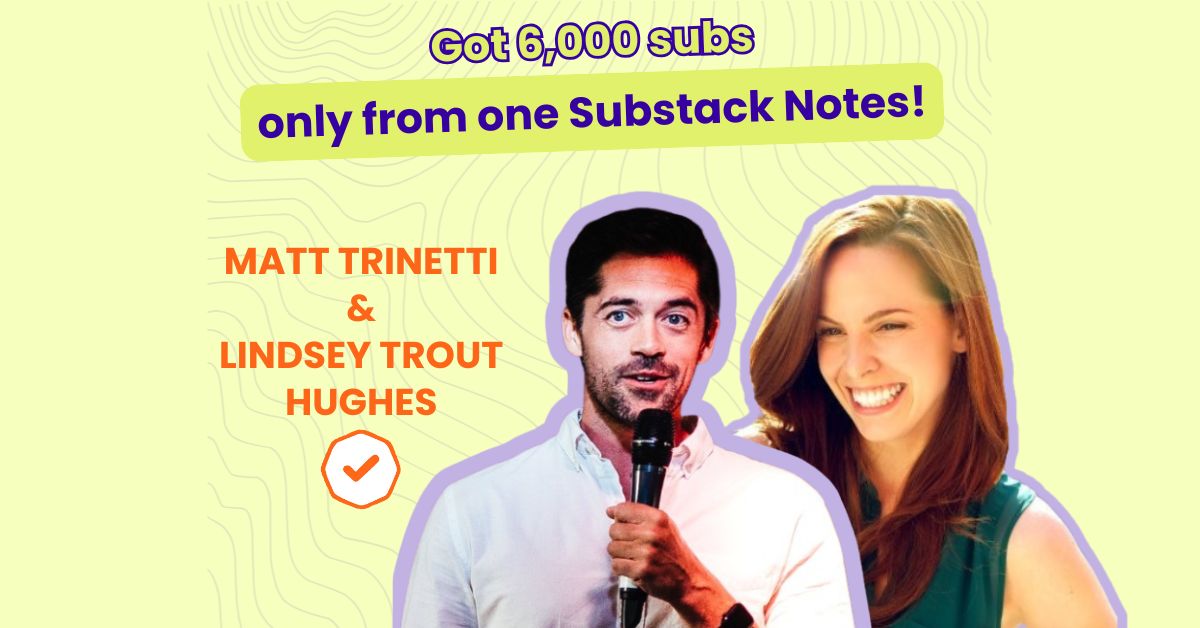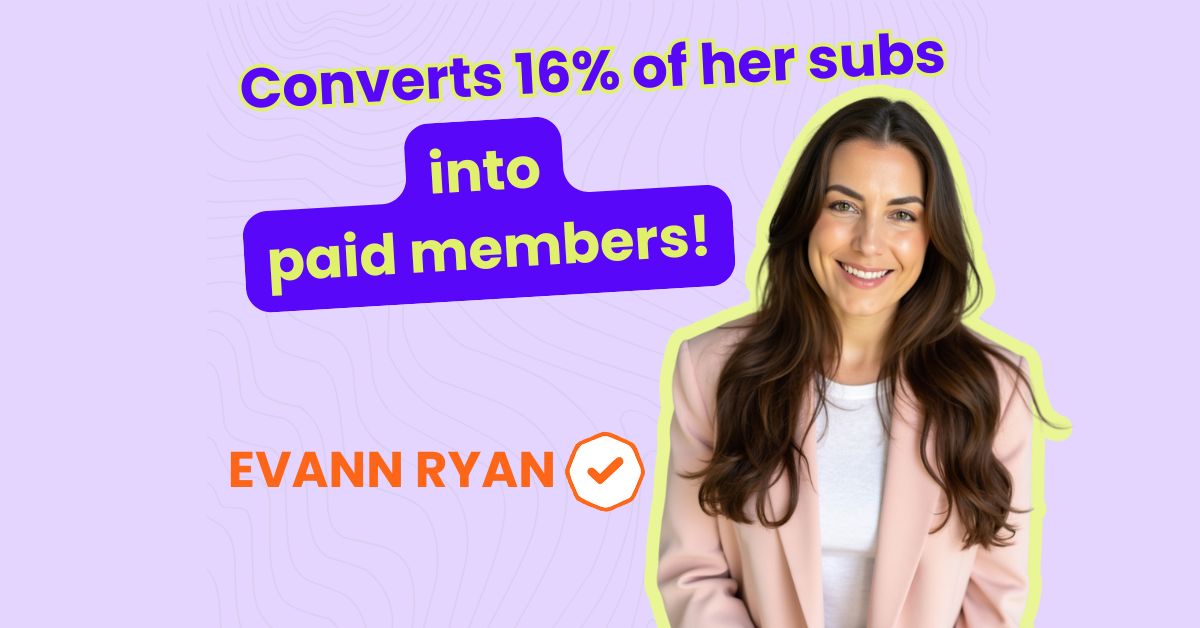Interview Date: 29th of June
Table of Content
- Meet Tom Kuegler
- Newsletter Identity Card
- His content and Substack journey
- How he grew ~18,000 subcribers
- His Substack Notes strategies to grow his audience
- Strategies he used to reach 240+ paid members
- His tool stack to run his content business
- Personal & professional impact of running a newsletter
MEET THE CREATOR
Tom Kuegler has been in the online writing game long before Substack existed: first on Medium, then YouTube, then LinkedIn. Now, he’s bringing all of that experience into one focused, long-term project: The Writing Long Game, where he teaches creators how to grow online without chasing hacks or burning out.
Tom’s strategy is rooted in patience, consistency, and building systems that scale like using Substack Notes to grow by 10,000+ subscribers and AI tools to turn his knowledge into digital products.
With over 17,000 subscribers, 240+ paying members, and a vibrant writing community, Tom is showing creators that playing the long game pays off.
In this interview, you’ll learn:
- How Tom gained 10,000+ subscribers using Substack Notes
- His strategy for converting readers using AI-powered tools
- What he wishes he built before going viral
- Why your paid offer should be part of an ecosystem, not a one-off
- The #1 piece of advice he gives to creators starting today
Enjoy!
NEWSLETTER IDENTITY CARD
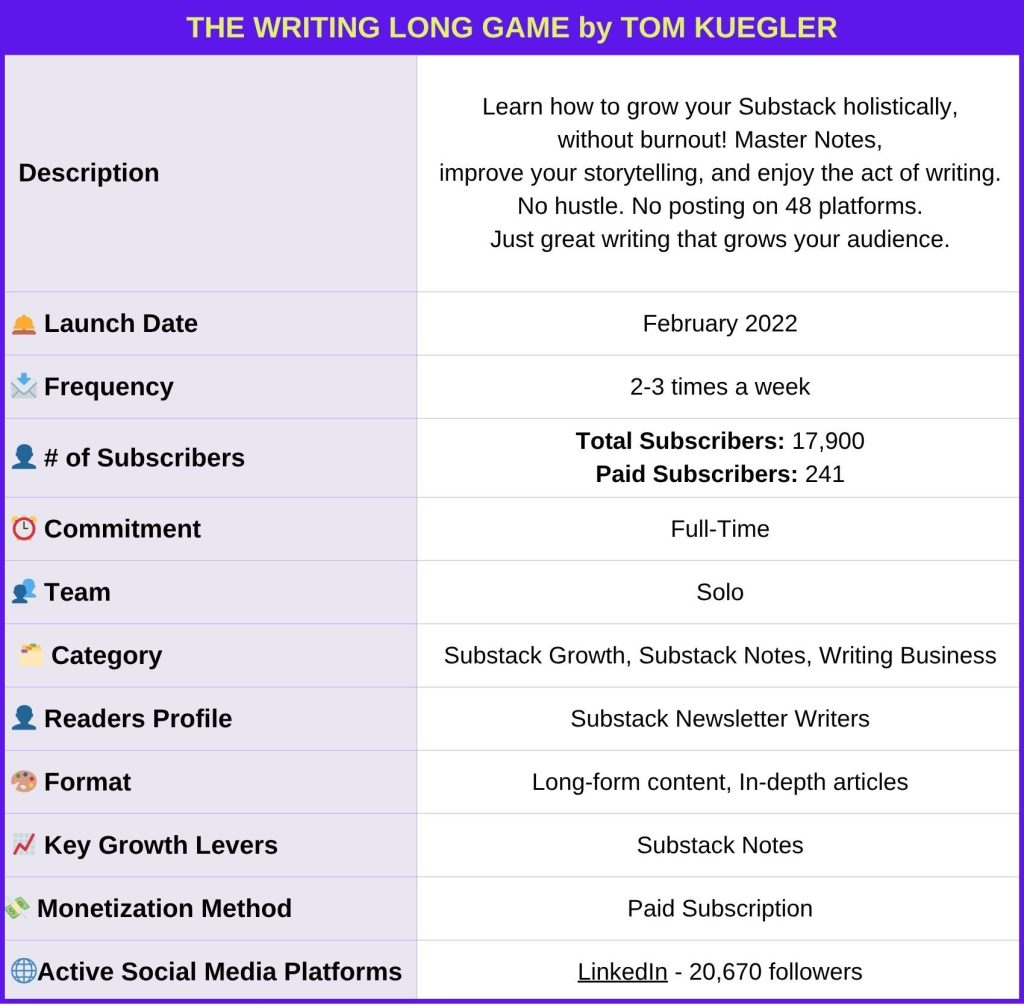
START
Welcome Tom. Let’s start with getting to know you.
I started writing online in late 2016 on Medium. I’d been freelancing for about a year and a half at that point, getting jobs on Upwork and working a remote job. But I loved writing and always enjoyed it.
In 2016, I went on a four-month road trip across 23 states, and I had so much I wanted to write about and teach people. So I went to Medium, created my own publication, and started writing once every weekday.
I wanted to speak to recent grads who felt lost—because I felt very lost after graduating college. I wanted to give them hope, direction, and inspiration by sharing how I got started with freelancing, escaped corporate life, traveled, and met cool people.
I built up to 10,000 followers over the course of one year on Medium. People started asking questions about how to grow on the platform, so I decided to make a course about it.
I held a webinar, sold the course, and got 15 people to sign up, making $2,000 in a couple of hours. That was unbelievable for me—I’d never made that much for my own thing before. That was the turning point when I became a full-time creator and teacher.
I started a YouTube vlog in early 2018 because I wanted to be Casey Neistat. I focused on the Philippines in late 2018 after visiting for a month, and a couple of videos went viral. I grew by 25,000 followers overnight on Facebook, so I decided to move back to the Philippines to take advantage of the attention.
I lived there for a couple of years, made videos about the Philippines, and grew my Facebook page to 500,000 followers. I also kept writing on Medium and had several six-figure years from 2019 to 2022.
I came back home in 2020, moved to Mexico in summer 2021, and transitioned off Medium around 2021 to focus on LinkedIn. I created writing programs and ran LinkedIn sprints for about two and a half years.
Then I got on Substack in 2023. It was slow going initially, but I discovered Notes in early 2024 and grew by 10,000 email subscribers over the course of a year just by writing viral Notes and being very active. It’s been a huge renaissance for my business, and now I’m starting to get back into YouTube with a focus on AI.
How and why did you start The Writing Long Game in the first place?
I started the newsletter in mid-2023 and originally called it “Mind of a Writer,” which honestly doesn’t make any sense. I wanted to publish writing advice and focus more on the mindset of being a writer online rather than just growth hacks.
But in late 2024, I decided to rebrand because “Mind of a Writer” just didn’t work for me.
“The Writing Long Game” made more sense because I’d already been talking to people about slow growth and thinking long-term when trying to grow online. I wanted to showcase that this isn’t a publication where you’ll learn growth hacks to get 10,000 subscribers overnight.
Yes, growth is part of what I do, but I’m expanding to cover how to grow, find your niche, get ideas, write better blog posts, and monetize. The rebrand gave me the runway to talk about every facet of growing online.
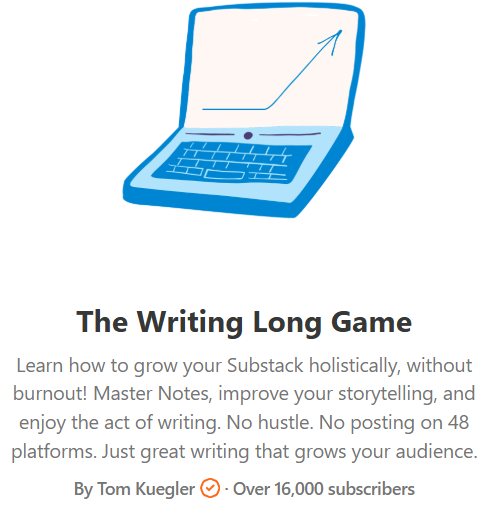
GROWTH
Which strategies did you use to grow over 17,900 subscribers?
0 – 100 Subscribers
This was easy because I already had an existing list on Medium. I just pointed them toward my Substack and got a couple of hundred subscribers overnight.
100 – 1,000 Subscribers
This happened through consistent posting and heavy commenting. In early 2024, when Notes were starting to take off for me, I spent a lot of time commenting on articles—maybe 10 articles a day—and being very active in the community. This helped me grow by dozens of subscribers every week.
I had this “50 in 7” challenge where you try to get 50 new subscribers in seven days through relentless commenting and making connections. The whole system for getting initial traction comes from commenting.
I also got tons of subscribers from recommendations because a friend who was big on Substack recommended my publication. Getting recommendations on Substack is crucial when you’re early in the game. The way to do that is by building connections through commenting. If you’re starting from scratch without any existing list, you have to be very active in the community.
1,000 – 10,000 Subscribers
This happened thanks to Notes. I started writing Notes every day and was getting thousands of subscribers per month during the summer. In April, May, and June, I was getting a couple thousand subscribers monthly. Notes by itself really grew the newsletter.
10,000+ Subscribers
It’s still Notes, but I’ve hit a plateau with Notes growth. I’m only getting a couple hundred new subscribers per month now, probably because people are already subscribed and the Notes ecosystem is relatively small. To get from 10,000 to 20,000-30,000, I want to start my YouTube channel and get traction there.
Regarding growth efforts, what would you do differently if you had a chance to start over?
Honestly, I don’t think I would have done much differently. Maybe I would have networked more and tried to get recommendation swaps. I’m really happy with how Notes grew for me.
If anything, I wish I could have gotten on Substack earlier—like in 2020—before it hit the mainstream. The lesson here is to try to get on new platforms earlier than everyone else. Getting there early is crucial for growth.
SUBSTACK NOTES
How does Substack Notes contribute to your newsletter subscriber growth?
Notes has been the main driver of my publication’s growth. The challenge now is that I’m not getting as many subscribers from Notes as I did last year.
I was getting thousands of likes on Notes last year, but the algorithm has changed and is favoring different types of creators. I’m getting maybe a couple hundred new subscribers per month from Notes now.
It’s still my number one growth driver, and Notes are also great for conversions—telling people about my tools and offerings.
What are the 3 key elements of a Note that converts readers into subscribers?
I actually don’t think about conversion that strategically. I focus more on being helpful and writing about what I care about each day. I let everything else fall into place, which might be a detriment, but that’s my approach.
What I do track is which topics tend to do well over time. I analyzed all my Notes in 2024 and identified 20-25 winning topics that consistently get good reactions. I keep touching on these themes and ideas that people respond to well.
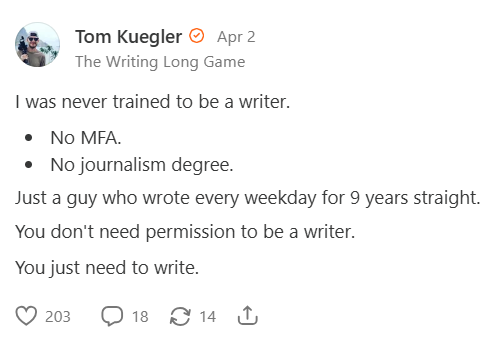
MONETIZATION
How many paid subscribers do you have and how long did it take to become a Bestseller?
I have 241 paid subscribers right now. It took about a year on Substack to become a bestseller, with Notes significantly driving that growth.
Honestly, I think I missed out last year because I didn’t have a great paid strategy. I wasn’t strategic about my paid memberships and had all these leads coming in from Notes that I didn’t convert properly.
This was challenging because I’m used to Medium, where you just lock posts and people pay to read them. On Substack, you need to include many different valuable elements for people to want to go paid.
When did you launch your paid subscription and how did you decide on the timing?
I launched my paid subscription a couple of months after getting on Substack. I wanted at least 1,000 free subscribers before launching paid, which I think is a good rule of thumb. I initially got about 30 paid subscribers when I launched.
What strategies work best to convert free subscribers into paid ones?
AI tools have been huge for me. I create AI tools that digitize my expertise and spend a lot of time getting the prompts right so they actually work for people. Paid subscribers get 50 credits per month for these tools, and as I build out my bank of AI tools, the whole system becomes more valuable.
Discounts also work very well for conversions. I typically launch new tools alongside discounts.
The other big strategy is quarterly online courses that cost $200-300. I have a founding member tier for $300 per year that gives access to all quarterly courses throughout the year—essentially a four-for-one deal. This helps convert both free subscribers and regular paid subscribers to founding members, which significantly boosts annual revenue.
What are the biggest lessons you’ve learned from running a successful paid subscription?
Everything you offer in your paid subscription should add to the entire ecosystem rather than being disjointed. Instead of making a training about headlines one month and personal development the next, everything should work together to make the entire paid subscription more valuable.
I was way too scattered in the past without an overarching plan. Now I’m thinking about what I want to add over the next year to make it a no-brainer for people to sign up. When someone becomes a paid subscriber, they get access to everything in your library—posts, resources, courses—so it all needs to make sense as a cohesive ecosystem.
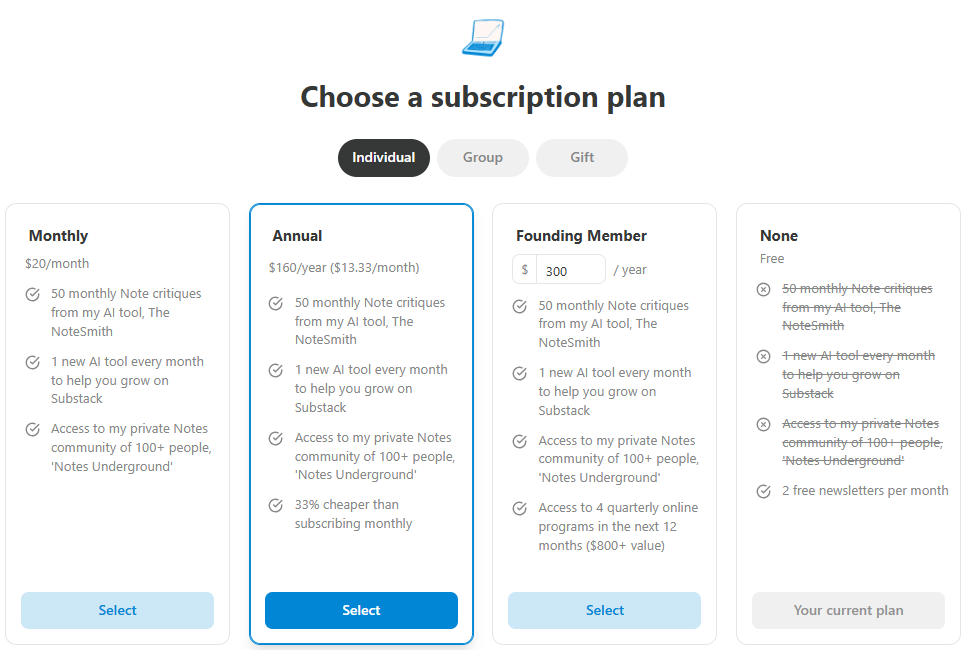
TOOL STACK
Could you share the breakdown of the tools you use to run your Substack and overall content business?
Writing & Email:
- Substack – My primary platform for email and publishing.
- ChatGPT & Claude – I use AI to help with promotional sections I don’t enjoy writing, along with auto-generating some of my Notes on occasion.
- My own AI bots like the NoteSmith and TitleSmith (built with Pickaxe.co) – These help me write headlines, Notes, and more. These tools are actually part of my paid subscription at the Writing Long Game. If you want to see what my suite looks like, go here. Paid subscribers get access to another link that gives them 50 monthly credits.
Content Planning & Task Management:
- Bullet Journal Method (analog) – For daily/monthly task tracking.
- Coda – My digital HQ for content planning, time tracking, and note-taking.
Landing Pages & Email Funnels:
- Systeme.io – Lightweight and affordable alternative to ClickFunnels for lead magnets and automation.
Community & Internal Tools:
- Slack – For running my community.
- Softr + Airtable – I built Notes Underground, my writing app, using these tools. Members log Notes, view stats, and connect by niche type. Softr creates the front facing app that people engage with, and Airtable logs all the data. Here is the site notesunderground.club.
Payments & Documents:
- Stripe – Handles all payments.
- Google Docs – For misc. writing and collaboration (though I’m shifting more to Coda).
Design & Video:
- PicMonkey – For YouTube thumbnails and branding visuals. I use this to design my publication’s logo, branding stuff, and occasionally cover photos for blog posts and AI tools I’ve made.
- Adobe Premiere Pro – For YouTube editing.
- QuickTime – For screen recording demo clips and b roll footage.
Transcription & Live Teaching:
- Otter.ai – To transcribe voice notes I later turn into content.
- Zoom – For live courses, teaching sessions, and community events.
IMPACT & LEARNINGS
How did building The Writing Long Game newsletter contribute to your life professionally and personally?
Personally, it meant everything. I’d been on Medium from 2020-2022 when it went downhill for me, so I had to jump ship to Substack.
After spending years on LinkedIn with a very professional audience who weren’t writers at their core, coming to Substack felt like a homecoming. I was around my people again—writers who understood what I was publishing because it came from what I actually felt.
The Writing Long Game has given me clarity about what I want to do with the publication and where I want to go in future years. Unlike social media platforms where algorithms determine your reach, on Substack I can email my subscriber list whenever I want and generate 100,000+ views per month easily. Having that control over my audience is incredible.
What would you do differently if you had a chance to start over The Writing Long Game?
I would definitely have a much more robust paid membership built before going viral on Notes. When you’re starting to grow anywhere, you need the monetization scaffolding in place before you go viral.
I also wish I’d had more of an overarching plan from the beginning instead of just publishing whatever I
wanted. Having a strategic roadmap would have been much more effective.
What’s your one piece of advice for aspiring newsletter creators?
Talk to ChatGPT about everything. Use it to think through what you want to write about, how you could monetize, analyze posts that are doing well or poorly—everything.
But more importantly, get deeply involved in the community. A lot of people struggle on Substack wondering why they’re not getting views, and it’s because they’re not talking to anybody. You’re not part of the community and nobody knows who you are. You have to give in order to receive, especially when you’re starting out.
Where to find Tom Kuegler
- “The Writing Long Game” Newsletter

